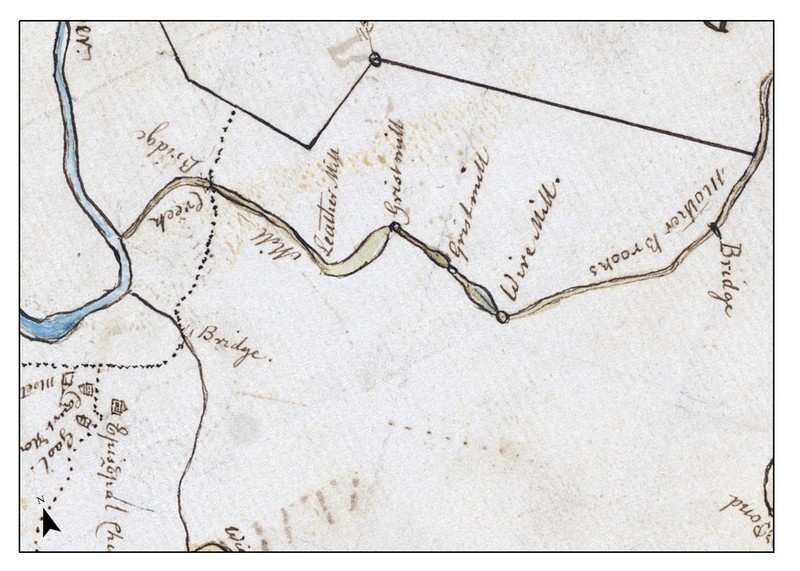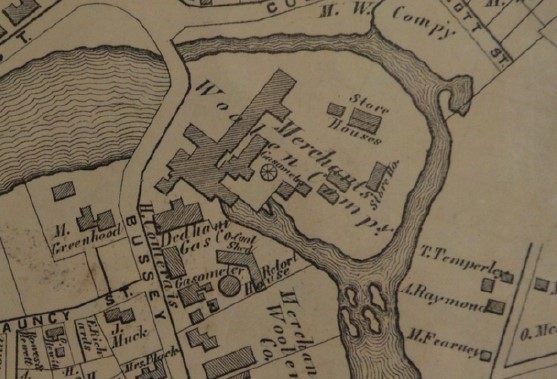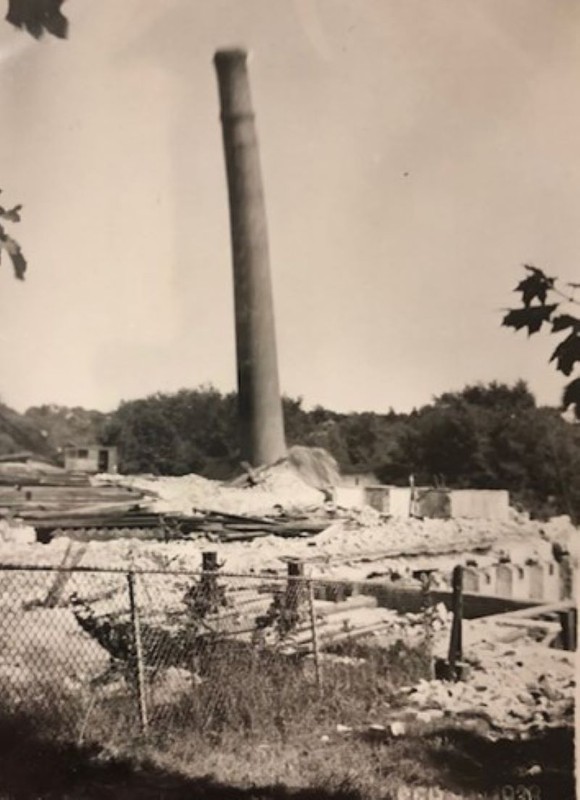First Privilege & Merchants Woolen Mill
Introduction
Text-to-speech Audio
This is the location of the first mill built in Dedham by John Elderkin and Nathanial Whiting in 1641 to grind corn. It is known as the First Privilege, a privilege being the right of a mill-site owner to construct a mill and to use power created by damming the stream to operate the mill. Today this property is the site of Condon Park, but it once included the largest of Dedham's textile mills, Merchants Woolen Mills. The only factory building remaining at this site is the brick structure at 202 Bussey Street, known as Merchants Woolen Mill No 2 built circa 1855. This low, gable-roofed brick structure recalled the massive factory that once stood at this site until it was demolished in the 1930s. This privilege was powered by a dam located roughly in the same location as the Colburn Street Dam is locate today.
Images
Map of Mother Brook in 1795 noting the location of the four privileges and mills.

1876 Map with the layout of the Merchants Woolen Mill buildings and Mill No. 2 building visible.

Hodges Finishing Company located here.
.jpg)
Merchants Woolen Mill and workforce circa 1887
.jpg)

Backstory and Context
Text-to-speech Audio
John Elderkin and Nathanial Whiting built a corn mill here at the first privilege on Mother Brook in 1641. A corn grist mill continued here until it was purchased in 1821 by the Dedham Worsted Company, the first textile manufactory to operate at this privilege. Benjamin Bussey purchased the mill and privilege in 1824 and it was under his leadership that the business expanded significantly. Bussey purchased both the first and second privileges to produce cotton and later woolen fabrics. He constructed several brick buildings at both this site and at Maverick Street along with several dwellings and boarding houses for his employees.[1]
J. Wiley Edmunds purchased the factory buildings at the first and second privileges in 1843 and with several other investors formed the Maverick Woolen Mills came into existence in 1843 acquiring the mill buildings from Bussey. Merchants Woolen Company took control of the Maverick Company in 1863 and continued to operate at this site for several decades. In a newspaper article dating from 1887, the mill was described as one of the largest of its kind in the state, employing nearly 500 hands.[2] An image from around that time period shows the employees standing on balconies, rooftops, and in front of the building (Figure 4). The article went on to say that the plant produced “cheviots, worsted, plan and fancy beavers…[and],,,will in a few days shut down entirely. Hopeful that the work would resume by the following spring.”[3] Dullness in the woolen market was cited as the reason for the closure. The company had recently begun to specialize in the production of heavy-grade woolens and faced steep competition from lighter and cheaper-grade imports. These imports were cited as the chief reason that the workforce was cut to just 80 employees. Since the woolen mills were considered the “chief industry to the town” this was described as a “serious blow” to its citizens.3 In 1895 it was taken over by Edward D. Thayer who revived the business and again employed just over 500 local citizens. At the time, the total population of Dedham was only 7,211.
The Hodges Finishing Company took over the buildings in 1909. This “new” plant was located in old buildings of the Merchants Woolen Mill. Some changes were made to the interiors to accommodate new processes, but the exterior remained the same. Hodges specialized in bleaching, finishing, and mercerizing at first and later expanded to dying fabrics.[4] At the time 300 employees were working at the plant.[5] By 1922 it was reported that the number of people employed by the company had dropped to 150.[6] As manufacturing in the American south and foreign markets became more competitive, the textile. The Hodges company complex closed in the late 1920s and all but Mill No. 2 was demolished circa 1930.
The Merchants Woolen Company Factory Mill No. 2 located at 202 Bussey Street, is a 2.5-story brick, gable-fronted building with a flat-roofed, single-story side ell attached to the southern elevation. Mill No. 2 was constructed for the Maverick Company circa 1855, as a building of the same size and shape appears on the 1855 map of the company’s property. One half of the building housed a spinning mule and a storeroom and the other half housed the carpenter shops with spinning taking place on the first and second stories. A spinning mule is a machine used to spin cotton and other fibers into fine cloths such as cashmere and other knit wares. A former race (waterway) runs in a southeasterly direction underneath the building and still accommodates overflow during periods of high water.
Sources
[1] Erastus Worthington, Historical Sketch of Mother Brook, Dedham, Mass. (Dedham, MA: Press of C. G. Wheeler, 1900), 11.
[2] New York Times, June 7, 1887:
[3] Ibid
[4] Textile World, Record Volume 38, Issue 2, Boston, MA: Lord & Nagle, Co., November 1909.
Dedham Museum and Archives
Dedham Museum and Archives
unknown
Dedham Museum and Archives
Dedham Museum and Archives
